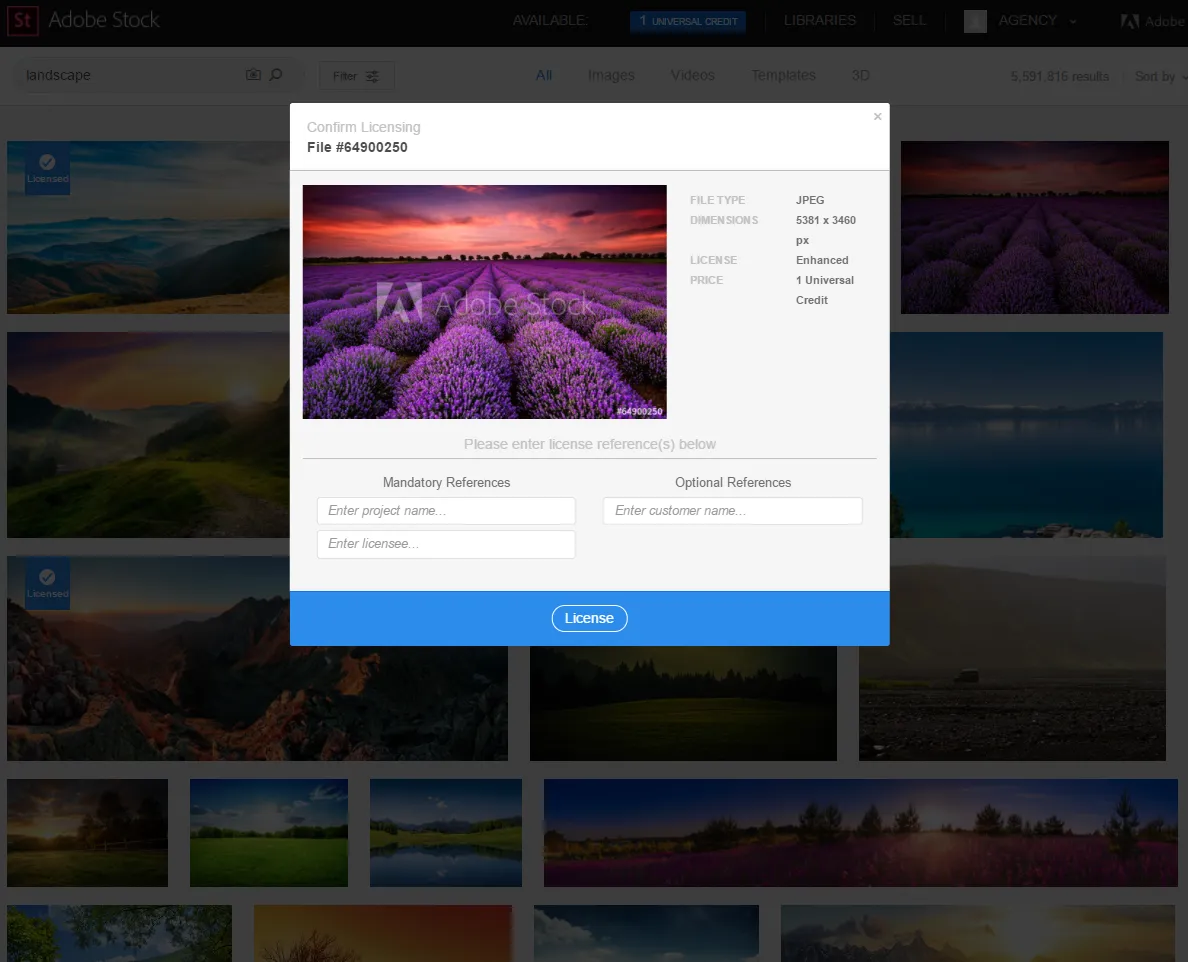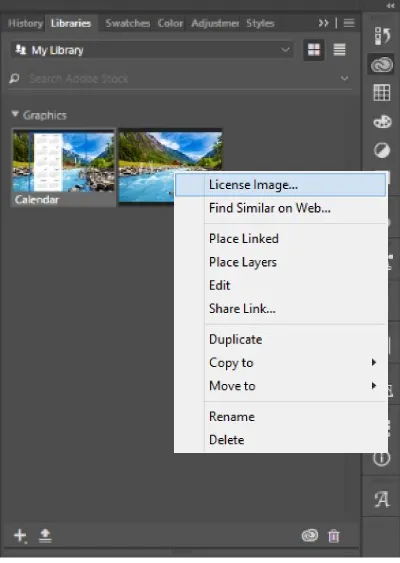Adobe Stock is a powerful resource for creatives, designers, and businesses seeking high-quality assets to enhance their projects. It offers a vast library of millions of royalty-free images, videos, templates, and 3D assets, ensuring you have access to the content you need to bring your ideas to life. With Adobe Stock, you can find everything from stunning photography to eye-catching graphics, all curated to meet the demands of modern creative projects.
One of the standout features of Adobe Stock is its seamless integration with Adobe Creative Cloud applications like Photoshop, Illustrator, and InDesign. This means you can easily search for and license assets directly within your favorite Adobe tools, streamlining your workflow and saving you precious time. Whether you're a freelancer, a small business owner, or part of a large corporation, Adobe Stock provides flexible pricing options and a wide range of usage rights that cater to various needs.
What is a Standard License?

The Standard License from Adobe Stock is designed to offer a broad range of usage rights while maintaining affordability for users. This license is ideal for most everyday creative projects, making it a popular choice among designers and businesses alike. But what exactly does it cover?
With a Standard License, you can use the licensed content in various formats and media, including:
- Websites: Use images and videos on your website or in digital marketing campaigns.
- Social Media: Share licensed content on social media platforms without restrictions.
- Print Materials: Create printed materials such as brochures, flyers, and posters, up to a maximum of 500,000 copies.
- Presentations: Use assets in presentations for clients or internal meetings.
However, it's essential to note that the Standard License does come with some limitations:
- Cannot be used for merchandise or products meant for resale.
- Cannot be used in a way that could imply endorsement or sponsorship.
- Limited to specific types of content, such as images and videos; certain assets may require an Extended License for broader usage.
In summary, the Standard License provides a flexible and cost-effective way to access a wealth of creative resources, making it easier for you to enhance your projects while staying compliant with usage rights. Always review the licensing terms before diving in, so you can make the most of what Adobe Stock has to offer!
Also Read This: How to Sell Stock Photos to Getty Images for Beginners
3. Pricing Structure of Adobe Stock Standard License

Understanding the pricing structure of Adobe Stock's Standard License is crucial for anyone looking to incorporate stock images into their projects. Adobe Stock offers a variety of pricing options that cater to different needs and budgets. Here’s a rundown of how their pricing works:
- Subscription Plans: Adobe Stock provides several subscription options. You can choose a monthly or annual plan. Monthly plans offer flexibility, while annual plans often come with a discounted rate.
- Image Packs: If you don't need a subscription, you can purchase image packs. These packs allow you to buy a set number of images at a lower price than purchasing them individually.
- On-Demand Purchases: For occasional users, Adobe Stock allows you to buy images on-demand. This means you pay for each image as you need it, without committing to a subscription.
- Pricing Tiers: The cost of images can vary based on their size and resolution. The standard pricing typically starts at around $29.99 for a standard image, but this can fluctuate based on promotions and discounts.
In summary, Adobe Stock’s pricing structure is designed to be flexible, catering to both casual users and businesses needing consistent access to high-quality images. Whether you opt for a subscription, image pack, or on-demand purchase, understanding these options will help you make the best choice for your project needs.
Also Read This: Mastering High-Precision Football Shots on the Field
4. Comparing Standard License with Other License Types
When diving into the world of stock images, it's essential to understand the different license types that Adobe Stock offers. The Standard License is one of the most commonly used, but how does it stack up against other options? Let's break it down:
| License Type | Usage Rights | Restrictions |
|---|---|---|
| Standard License |
|
|
| Extended License |
|
|
| Editorial License |
|
|
In a nutshell, the Standard License is great for most projects, especially if you need flexibility for marketing materials or digital content. However, if you're planning to sell merchandise or need broader usage rights, you might want to look into the Extended License. On the other hand, if your work is strictly editorial, then the Editorial License will be the way to go. Always consider your project's specific needs before making a decision!
Also Read This: Behance platform overview
Usage Rights Explained
When you dive into Adobe Stock, understanding the usage rights associated with the assets you purchase is crucial. Adobe offers a variety of licenses, but for this discussion, we’ll focus on the *Standard License. This license gives you the flexibility to use assets in multiple projects, but there are some important limitations to keep in mind.
The Standard License allows you to:
- Use assets for personal and commercial projects.
- Include the assets in digital products for resale, provided they are incorporated into a larger design like a website or app.
- Use the assets in social media posts, advertisements, and marketing materials.
However, there are restrictions you should be aware of:
- No merchandise: You cannot use the stock images or videos on items for resale, like t-shirts or mugs.
- No standalone use: The asset should not be used in a way that allows others to use it separately from your project.
- Limited print runs: If you’re printing materials, make sure your print run doesn’t exceed 500,000 copies.
In essence, the Standard License is designed to provide a wide range of usage while protecting the rights of the creators. It's always a good idea to read the full licensing agreement for a comprehensive understanding.
Also Read This: How to Sell Photography on Shutterstock and Stand Out
Common Questions About Adobe Stock Licensing
When it comes to Adobe Stock and its licensing, many users have questions. Here are some of the most common queries to help clarify your doubts:
| Question | Answer |
|---|---|
| What is the difference between Standard and Extended licenses? | The Standard License covers most uses, while the Extended License* allows for larger print runs and merchandise use. |
| Can I use Adobe Stock assets in my logo? | No, Adobe Stock assets cannot be used to create a logo or trademark. |
| Do I need to credit the creator of the stock asset? | Credit is not required, but it is appreciated and can be a great way to support the artist. |
| Can I modify the stock images? | Yes, you can modify the images to fit your project needs, as long as you adhere to the licensing terms. |
| What happens if I exceed the usage limits? | Exceeding usage limits may lead to legal issues, so it’s best to purchase an Extended License if you anticipate needing more flexibility. |
By understanding these common questions, you can navigate Adobe Stock’s licensing with greater confidence, ensuring you use assets appropriately and legally in your projects!
Understanding Adobe Stock Standard License Pricing and Usage Rights
Adobe Stock is a popular platform that provides high-quality stock images, videos, templates, and other creative assets for various projects. When using Adobe Stock, it is crucial to understand the pricing structures and the usage rights associated with the Standard License. This knowledge ensures compliance and maximizes the value of your purchase.
Pricing Structure
Adobe Stock offers several pricing options for users, allowing flexibility based on individual or business needs. The main pricing models include:
- Subscription Plans: Monthly or annual subscriptions that provide a certain number of assets per month at a reduced rate.
- Credit Packs: Purchase credits upfront and use them as needed for individual assets.
- On-Demand Purchases: Pay per asset without any commitment, ideal for one-time projects.
Usage Rights Under the Standard License
The Standard License from Adobe Stock comes with specific usage rights. Here are the key points:
| Usage Rights | Details |
|---|---|
| Commercial Use | Allowed for advertisements, websites, and promotional materials. |
| Editorial Use | Permitted for newsworthy content and non-commercial projects. |
| Modification | Assets can be modified or altered to fit your project needs. |
| Distribution | Limited distribution; cannot be resold or redistributed as standalone assets. |
Understanding these pricing and usage rights is essential for leveraging Adobe Stock effectively in your creative projects.
Conclusion and Final Thoughts
In conclusion, Adobe Stock's Standard License offers a flexible pricing model and comprehensive usage rights that cater to a range of creative needs. By familiarizing yourself with these aspects, you can make informed decisions and utilize the platform's resources effectively while ensuring compliance with licensing agreements.